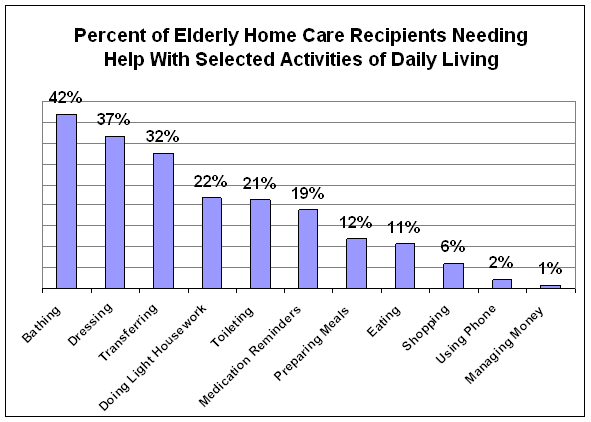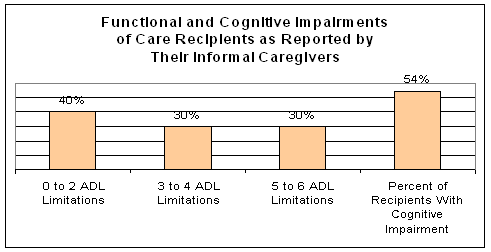The History of Home Care
By the end of the 1950s it was apparent that Social Security beneficiaries were living longer and that the nursing home subsidy could eventually bankrupt Social Security. But in order to protect the thousands and thousands of existing nursing homes Congress had to find a way to provide a subsidy but remove it as an entitlement under Social Security. In 1965 Medicare and Medicaid were created through an amendment to the Social Security Act. Under Medicare, nursing homes were only reimbursed on behalf of Social Security beneficiaries for short-term rehabilitation. Under Medicaid, nursing homes were reimbursed for impoverished disabled Americans and impoverished aged Americans over the age of 65. It has never been the intent of Congress to pay for nursing home care for all Americans. The nursing home entitlement for all aged Americans was now gone.
Over the last 40 years, there has been a gradual change away from the use of nursing homes for long-term care towards the use of home care and community living arrangements that also provide in-house care.
With Proper Planning People Could Remain in Their Homes for the Rest of Their Lives
We are seeing a trend towards working conditions like those in urban America in the early 1900's where both husband and wife are working and putting in longer hours. We are also seeing a return of the trend in the early part of the 20th century where outside visitor caregivers are becoming available to replace working caregiver's and allow the elderly to receive long-term care in their homes. In addition there is a significant trend in the past few years for Medicaid and Medicare to pay for long-term care in the home instead of in nursing homes.
Given enough money for paid providers or government funding for the same, a person would never have to leave his home to receive long-term care. All services could be received in the home. Adequate long-term care planning or having substantial income can allow this to happen.
We only need to look at wealthy celebrities to recognize this fact. Christopher Reeve, the movie star, was totally disabled but he had enough money to buy care services and remain in his home. President Ronald Reagan suffered from Alzheimer's for many years but received care at his California ranch. He was also wealthy enough to pay for care when needed. Or what about Annette Funicello or Richard Pryor? Income from their movie careers allowed them to receive care with their multiple sclerosis at home. We will be willing to bet that Mohammed Ali, who is severely disabled with Parkinson's disease, will probably never see the inside of a care facility, unless he chooses to go there to die. With the proper planning and the money it provides, most of us could remain in our homes to receive long-term care and we would never have to go to an institution or a hospital.
The Popularity of Home Care
Most of those receiving long-term care and most caregivers prefer a home environment. Out of an estimated 8 million older Americans receiving care, about 5.4 million or 67% are in their own home or the home of a family member or friend. Most older people prefer their home over the unfamiliar proposition of living in a care facility. Family or friends attempt to accommodate the wishes of loved ones even though caregiving needs might warrant a different environment. Those needing care feel comfortable and secure in familiar surroundings and a home is usually the best setting for that support.
Often the decision to stay in the home is dictated by funds available. It is much cheaper for a wife to care for her husband at home than to pay out $2,000 to $4,000 a month for care in a facility. Likewise, it's much less costly and more loving for a daughter to have her widowed mother move in to the daughter's home than to liquidate mom's assets and put her in a nursing home. Besides, taking care of our parents or spouses is an obligation most of us feel very strongly about.
For many long-term care recipients the home is an ideal environment. These people may be confined to the home but continue to lead active lives engaging in church service, entertaining grandchildren, writing histories, corresponding, pursuing hobbies or doing handwork activities. Their care needs might not be that demanding and might include occasional help with house cleaning and shopping as well as help with getting out of bed, dressing and bathing. Most of the time these people don't need the supervision of a 24/7 caregiver. There are, however, some care situations that make it difficult to provide long-term care in the home.
Please note from the first graph below that a great amount of home care revolves around providing help with activities of daily living. Note from the second graph below that the average care recipient has need for help with multiple activities of daily living. Finally, it should be noted from the second graph that well over half of home care recipients are cognitively impaired. This typically means they need supervision to make sure they are not a danger to themselves or to others. In many cases, this supervision may be required on a 24-hour basis. (Graphs were derived from the 1999 national caregivers survey, courtesy www.longtermcarelink.net.)


Problems That May Prevent Home Care from Being an Option
Caregivers face many challenges providing care at home. A wife caring for her husband may risk injury trying to move him or help him bathe or use the toilet. Another situation may be the challenge of keeping constant surveillance on a spouse with advanced dementia. Or a son may live 500 miles from his disabled parents and find himself constantly traveling to and from his home, trying to manage a job and his own family as well taking care of the parents. Some caregivers simply don't have the time to watch over loved ones and those needing care are sometimes neglected.
The problems with maintaining home care are mainly due to the inadequacies or lack of resources with informal caregivers, but they may also be caused by incompetent formal caregivers. These problems center on five issues:
- Inadequate care provided to a loved one
- Lack of training for caregivers
- Lack of social stimulation for care recipients
- Informal caregivers unable to handle the challenge
- Depression and physical ailments from caregiver burnout
Adequate Funding Solves Most Problems Associated with Providing Home Care
None of the problems discussed in this article would be an obstacle if there were enough money to pay for professional services in the home. These services would be used to overcome the problems discussed in the previous section. If someone desires to remain in the home the rest of his or her life, adequate preplanning could provide the solution.
This planning must occur prior to retirement. The most obvious way to provide sufficient funds for home care is to buy a long-term care insurance policy when someone is younger, healthy and able to afford the lower premiums. If insurance is not an option, then money must be put aside early in life to pay for care in the future. The only other option is to be rich.
Unfortunately, very few people address the issue of needing long-term care when they are older. This leads to a lack of planning and in turn leads to few options for elder care when the time comes. Lack of planning means most people do not have the luxury of remaining in their homes and must rely on Medicaid support in a nursing home to finish out the rest of their lives.


0 Comments:
Post a Comment
Subscribe to Post Comments [Atom]
<< Home